Indoor Daylighting and Thermal Response of a Passive Solar Building to Selective Components of Solar Radiation
Abstract
1. Introduction
2. Components of Solar Radiation
3. Building and Site Description
4. Methodology
4.1. Solar Monitoring System
4.2. Thermal Monitoring
4.3. Illuminance Measurement
5. Results and Discussions
5.1. Analysis of Solar Radiation Components
5.2. Thermal Response Analysis
5.3. Indoor Illuminance Response
6. Conclusions
Author Contributions
Funding
Institutional Review Board Statement
Informed Consent Statement
Data Availability Statement
Acknowledgments
Conflicts of Interest
Nomenclature
| CO2 | Carbon dioxide |
| DA | Daylighting Autonomy |
| DHI | Direct horizontal irradiance |
| DNI | Direct normal irradiance |
| GHG | Greenhouse gas |
| GHI | Global horizontal irradiance |
| ħ | 99.99 W/m2 |
| H2O | Water vapor |
| HO2 | Hydroperoxyl |
| KT | Clearness index |
| Ld | Downward longwave irradiance |
| N2 | Nitrogen |
| O2 | Oxygen |
| SGD | SOLYS Gear Drive |
| UDI | Useful Daylight illuminance |
References
- International Energy Agency. Energy Technology Perspectives 2016: Towards Sustainable Urban Energy Systems; International Energy Agency: Paris, France, 2016; Available online: www.iea.org (accessed on 7 July 2019).
- Amasyali, K.; El-Gohary, N.M. A review of data-driven building energy consumption prediction studies. Renew. Sustain. Energy Rev. 2018, 81, 1192–1205. [Google Scholar] [CrossRef]
- Molina-Solana, M.; Ros, M.; Ruiz, M.D.; Gomez-Romero, J.; Martin-Bautista, M.J. Data science for building energy management: A review. Renew. Sustain. Energy Rev. 2017, 70, 598–609. [Google Scholar] [CrossRef]
- Priatman, J.; Soegihardjo, O.; Loekita, S. Towards Energy Efficient Facade Through Solar-powered Shading Device. Procedia-Soc. Behav. Sci. 2015, 179, 266–275. [Google Scholar] [CrossRef]
- Wang, H.; Sun, F.; Wang, T.; Liu, W. Estimation of daily and monthly diffuse radiation from measurements of global solar radiation a case study across China. Renew. Energy 2018, 126, 226–241. [Google Scholar] [CrossRef]
- Maleki, S.M.; Hizam, H.; Gomes, C. Estimation of Hourly, Daily and Monthly Global Solar Radiation on Inclined Surfaces: Models Re-Visited. Energies 2017, 10, 134. [Google Scholar] [CrossRef]
- Rossi, T.J.; Escobedo, J.F.; dos Santos, C.M.; Rossi, L.R.; da Silva, M.B.P.; Pai, E.D. Global, diffuse and direct solar radiation of the infrared spectrum in Botucatu/SP/Brazil. Renew. Sustain. Energy Rev. 2018, 82, 448–459. [Google Scholar] [CrossRef]
- Hinrichs, R.; Kleinbach, M. Energy: Its Use and the Environment, 5th ed.; BROOKS/COLE: New York, NY, USA, 2013. [Google Scholar]
- Gutiérrez-Trashorras, A.J.; Villicaña-Ortiz, E.; Álvarez-Álvarez, E.; González-Caballín, J.M.; Xiberta-Bernat, J.; Suarez-López, M.J. Attenuation processes of solar radiation. Application to the quantification of direct and diffuse solar irradiances on horizontal surfaces in Mexico by means of an overall atmospheric transmittance. Renew. Sustain. Energy Rev. 2018, 81, 93–106. [Google Scholar] [CrossRef]
- Coddington, O.; Lean, J.L.; Pilewskie, P.; Snow, M.; Lindholm, D. A solar irradiance climate data record. Bull. Am. Meteorol. Soc. 2016, 97, 1265–1282. [Google Scholar]
- Chwieduk, D. Solar Energy in Buildings: Thermal Balance for Efficient Heating and Cooling; Elsevier: Amsterdam, The Netherlands, 2014. [Google Scholar]
- Nelson, V.C.; Starcher, K.L. Introduction to Renewable Energy; CRC Press: Boca Raton, FL, USA, 2015. [Google Scholar]
- Mohammadi, K.; Shamshirband, S.; Petković, D.; Khorasanizadeh, H. Determining the most important variables for diffuse solar radiation prediction using adaptive neuro-fuzzy methodology; Case study: City of Kerman, Iran. Renew. Sustain. Energy Rev. 2016, 53, 1570–1579. [Google Scholar] [CrossRef]
- Ruiz-Arias, J.A.; Gueymard, C.A. Worldwide inter-comparison of clear-sky solar radiation models: Consensus-based review of direct and global irradiance components simulated at the earth surface. Sol. Energy 2018, 168, 10–29. [Google Scholar] [CrossRef]
- Gueymard, C.A. Cloud and albedo enhancement impacts on solar irradiance using high- frequency measurements from thermopile and photodiode radiometers. Part 1: Impacts on global horizontal irradiance. Sol. Energy 2017, 153, 755–765. [Google Scholar] [CrossRef]
- South Africa Weather Service. Climate South Africa. 2017. Available online: ftp://ftp.weathersa.co.za (accessed on 1 January 2017).
- Overen, O.K.; Meyer, E.L.; Makaka, G. Thermal, Economic and Environmental Analysis of a Low-Cost House in Alice, South Africa. Sustainability 2017, 9, 425. [Google Scholar]
- Mousazadeh, H.; Keyhani, A.; Javadi, A.; Mobli, H.; Abrinia, K.; Sharifi, A. A review of principle and sun-tracking methods for maximizing solar systems output. Renew. Sustain. Energy Rev. 2009, 13, 1800–1818. [Google Scholar] [CrossRef]
- Tang, W.; Yang, K.; He, J.; Qin, J. Quality control and estimation of global solar radiation in China. Sol. Energy 2010, 84, 466–475. [Google Scholar]
- Kipp & Zonen. Solar Monitoring Stations. 2012. Available online: http://www.kippzonen.com/Download (accessed on 24 May 2017).
- Campbell Scientific Inc. Solar Radiation Shields: For Temperature/Relative Humidity Sensors; Campbell Scientific Inc.: Utah, UT, USA, 2015; Available online: http://campbellsci.com/solar-radiation-shields (accessed on 19 September 2018).
- Jumo GmbH & Co. Construction and Application of Platinum Temperature Sensors; Jumo GmbH & Co.: Fulda, Germany, 2005; Available online: https://www.jumo.net/attachments/JUMO/attachmentdownload?filename=t90.6000gb.pdf&id=3008 (accessed on 19 November 2018).
- Moser, Y.; Gijs, M.A.M. Miniaturised flexible temperature sensor. J. Microelectromech. Syst. 2007, 16, 1349–1354. [Google Scholar]
- Campbell Scientific Inc. HMP60 Temperature and Relative Humidity Probe; Campbell Scientific Inc.: Utah, UT, USA, 2010. [Google Scholar]
- Yamazoe, N.; Shimizu, Y. Humidity sensors: Principles and applications. Sens. Actuators 1986, 10, 379–398. [Google Scholar]
- Rontronic Measurement Solutions. The Capacitive Humidity Sensor—How It Works & Attributes of the Uncertainty Budget; Rontronic Measurement Solutions: New York, NY, USA, 2016; Available online: https://www.rotronic.com/media/productattachments/files/c/a/capacitive_humidity_sensor_final.pdf (accessed on 13 September 2018).
- Biggs, W.W. Principles of Radiation Measurement; Lincoln: Dearborn, MI, USA, 2015; Available online: https://www.licor.com/documents/liuswfuvtqn7e9loxaut (accessed on 13 September 2018).
- Wang, C.; Tang, B.H.; Wu, H.; Tang, R.; Li, Z.L. Estimation of downwelling surface longwave radiation under heavy dust aerosol sky. Remote Sens. 2017, 9, 207. [Google Scholar] [CrossRef]
- Teodoro, P.E.; Delgado, R.C.; Oliveira-junior, J.F.; Gois, G.; Sohn, F.T. Incoming Longwave Radiation Evaluation for the Legal Amazon Using HadRM3 and Geostatistic Theoretical Models. Floresta Ambient. 2018, 25, 1–8. [Google Scholar]
- Stephens, G.L.; Wild, M.; Stackhouse, P.W.; L’Ecuyer, T.; Kato, S.; Henderson, D.S. The global character of the flux of downward longwave radiation. J. Clim. 2012, 25, 2329–2340. [Google Scholar] [CrossRef]
- Santos, C.A.C.D.; Silva, B.B.D.; Rao, T.V.R.; Satyamurty, P.; Manzi, A.O. Downward Longwave Radiation Estimates For Clear-sky Condition Over Northeast Brazil. Rev. Bras. Meteorol. 2011, 26, 443–450. [Google Scholar]
- Kreider, J.F.; Curtiss, P.S.; Rabl, A. Heating and Cooling of Buildings: Design for Efficiency, 2nd ed.; CRC Press: Denver, CO, USA, 2009. [Google Scholar]
- Paulescu, M.; Paulescu, E.; Gravila, P.; Badescu, V. Weather Modeling and Forecasting of PV Systems Operation; Springer Science & Business Media: London, UK, 2012. [Google Scholar]
- Lai, C.S.; Li, X.; Lai, L.L.; McCulloch, M.D. Daily clearness index profiles and weather conditions studies for photovoltaic systems. Energy Procedia 2017, 142, 77–82. [Google Scholar] [CrossRef]
- Ramgolam, Y.K.; Soyjaudah, K.M.S. Unveiling the solar resource potential for photovoltaic applications in Mauritius. Renew. Energy 2015, 77, 94–100. [Google Scholar] [CrossRef]
- Li, D.H.W.; Lou, S. Review of solar irradiance and daylight illuminance modeling and sky classification. Renew. Energy 2018, 126, 445–453. [Google Scholar] [CrossRef]
- Lou, S.; Li, D.H.W.; Lam, J.C. CIE Standard Sky classification by accessible climatic indices. Renew. Energy 2017, 113, 347–356. [Google Scholar] [CrossRef]
- Zhandire, E. Solar resource classification in South Africa using a new index. J. Energy S. Afr. 2017, 28, 61–70. [Google Scholar] [CrossRef]
- Yusuf, A. Characterization of Sky Conditions Using Clearness Index and Relative Sunshine Duration for Iseyin, Nigeria. Int. J. Phys. Sci. Res. 2017, 1, 53–60. [Google Scholar]
- SABS. SANS 204:2011-South African National Standard: Energy Efficiency in Buildings; SABS Standards Division: Pretoria, South Africa, 2011; Volume 1.
- Perin, A.N.; Bonamigo, D.F.; Ribeiro, M.D.Q.; Stock, R.A.; Remor, A.P.; Carvalho, D.D.; Steffani, J.A.; Bonamigo, E.L. Ergophthalmology in accounting offices: The computer vision syndrome (CVS). Rev. Bras. Oftalmol. 2017, 76, 144–149. [Google Scholar] [CrossRef]
- Krüger, E.L.; Tamura, C.; Trento, T.W. Identifying relationships between daylight variables and human preferences in a climate chamber. Sci. Total Environ. 2018, 642, 1292–1302. [Google Scholar] [CrossRef]
- de Bakker, C.; Aarts, M.; Kort, H.; Rosemann, A. The feasibility of highly granular lighting control in open-plan offices: Exploring the comfort and energy saving potential. Build. Environ. 2018, 142, 427–438. [Google Scholar] [CrossRef]
- Fryc, I.; Bisegna, F.; Tabaka, P. Lighting of recreation grounds as a source of sky glow—The influence of luminaire type on this phenomenon. In Proceedings of the Environment and Electrical Engineering and 2017 IEEE Industrial and Commercial Power Systems Europe (EEEIC/I&CPS Europe), Milan, Italy, 6–9 June 2017; pp. 1–4. [Google Scholar]
- Choi, J.-H.; Loftness, V.; Aziz, A. Post-occupancy evaluation of 20 office buildings as basis for future IEQ standards and guidelines. Energy Build. 2012, 46, 167–175. [Google Scholar] [CrossRef]
- Michael, A.; Gregoriou, S.; Kalogirou, S.A. Environmental assessment of an integrated adaptive system for the improvement of indoor visual comfort of existing buildings. Renew. Energy 2018, 115, 620–633. [Google Scholar] [CrossRef]
- Chi, D.A.; Moreno, D.; Navarro, J. Correlating daylight availability metric with lighting, heating and cooling energy consumptions. Build. Environ. 2018, 132, 170–180. [Google Scholar] [CrossRef]
- Mangkuto, R.A.; Rohmah, M.; Asri, A.D. Design optimization for window size, orientation, and wall reflectance with regard to various daylight metrics and lighting energy demand: A case study of buildings in the tropics. Appl. Energy 2016, 164, 211–219. [Google Scholar] [CrossRef]
- Bian, Y.; Ma, Y. Analysis of daylight metrics of side-lit room in Canton, South China: A comparison between daylight autonomy and daylight factor. Energy Build. 2017, 138, 347–354. [Google Scholar] [CrossRef]
- Carlucci, S.; Causone, F.; de Rosa, F.; Pagliano, L. A review of indices for assessing visual comfort with a view to their use in optimization processes to support building integrated design. Renew. Sustain. Energy Rev. 2015, 47, 1016–1033. [Google Scholar] [CrossRef]
- Pellegrino, A.; Cammarano, S.; Verso, V.R.M.L.; Corrado, V. Impact of daylighting on total energy use in offices of varying architectural features in Italy: Results from a parametric study. Build. Environ. 2017, 113, 151–162. [Google Scholar] [CrossRef]
- Visitsak, S.; Beltran, L.; Sridaranon, N. The Daylight Performance of an Integrated Skylight and Shading Dome for the Tropics. ISES Solar World Congr. 2017, 2017, 237–245. [Google Scholar] [CrossRef]
- Yu, X.; Su, Y. Daylight availability assessment and its potential energy saving estimation—A literature review. Renew. Sustain. Energy Rev. 2015, 52, 494–503. [Google Scholar] [CrossRef]
- Nabil, A.; Mardaljevic, J. Useful daylight illuminances: A replacement for daylight factors. Energy Build. 2006, 38, 905–913. [Google Scholar] [CrossRef]
- Li, D.H.W.; Lou, S.; Ghaffarianhoseini, A.; Alshaibani, K.A.; Lam, J.C. A review of calculating procedures on daylight factor based metrics under various CIE Standard Skies and obstructed environments. Build. Environ. 2017, 112, 29–44. [Google Scholar] [CrossRef]
- Al-Obaidi, K.M.; Ismail, M.A.; Rahman, A.M.A. Assessing the allowable daylight illuminance from skylights in single-storey buildings in Malaysia: A review. Int. J. Sustain. Build. Technol. Urban Dev. 2015, 6, 236–248. [Google Scholar] [CrossRef]
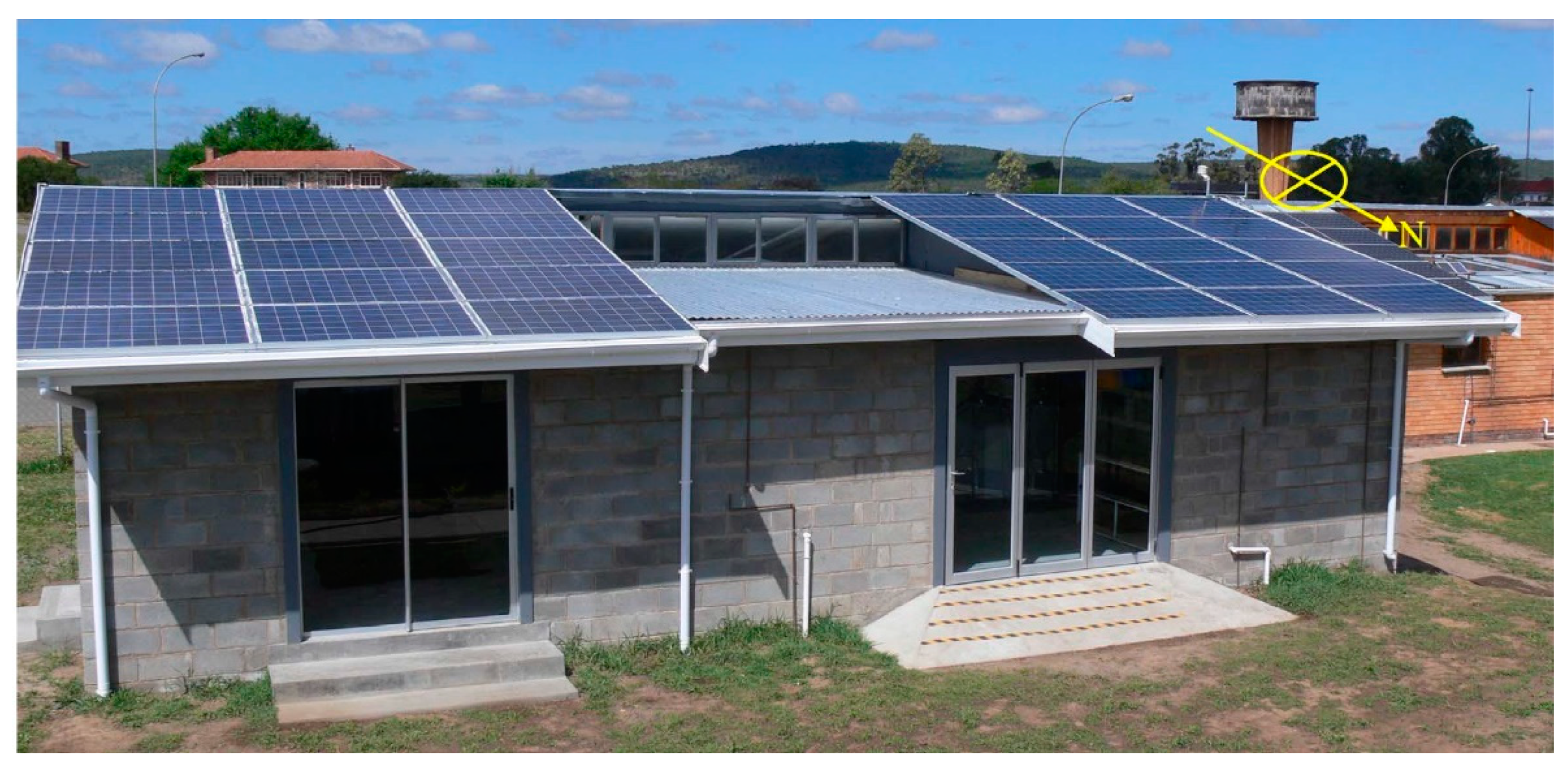
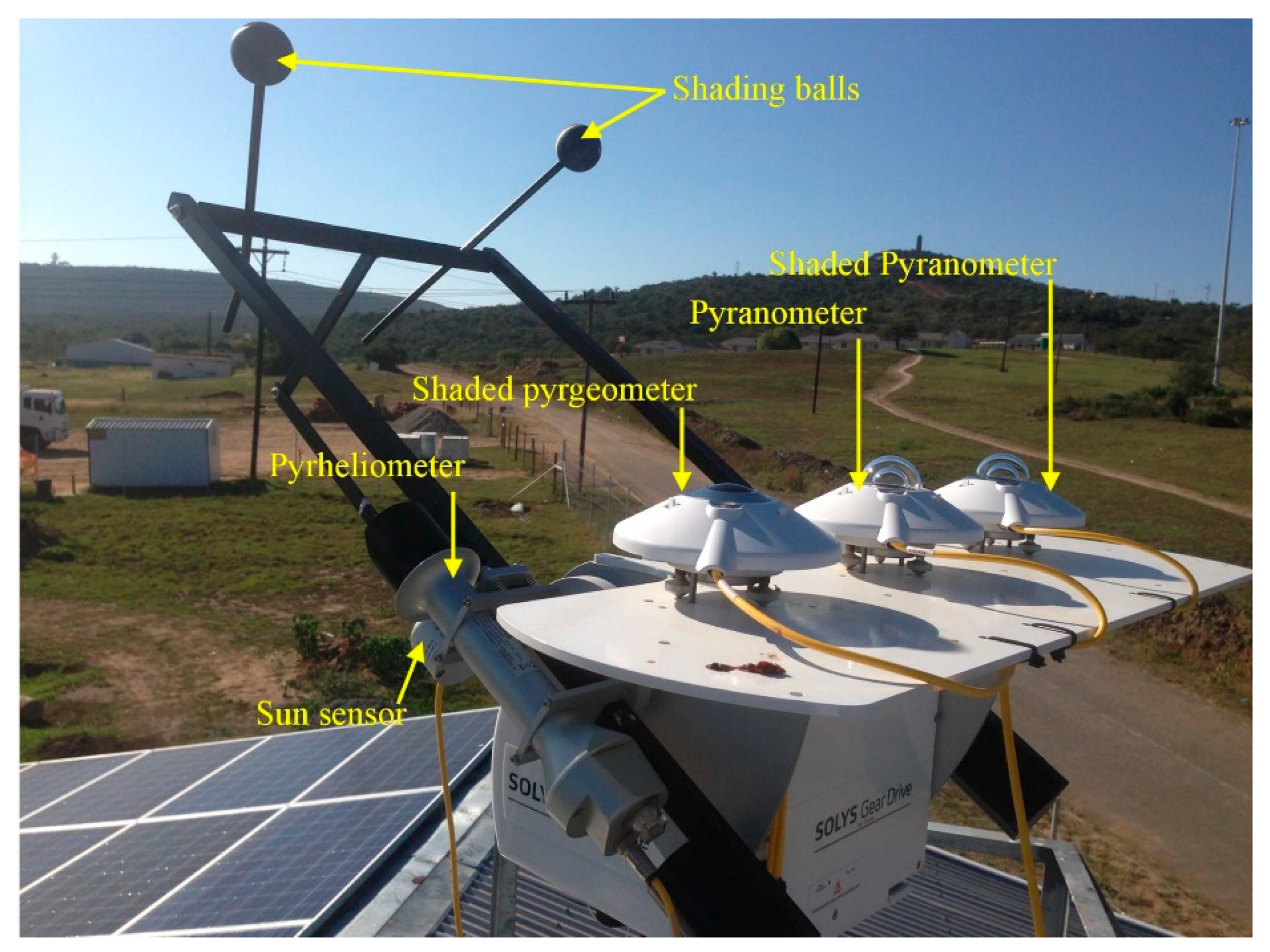
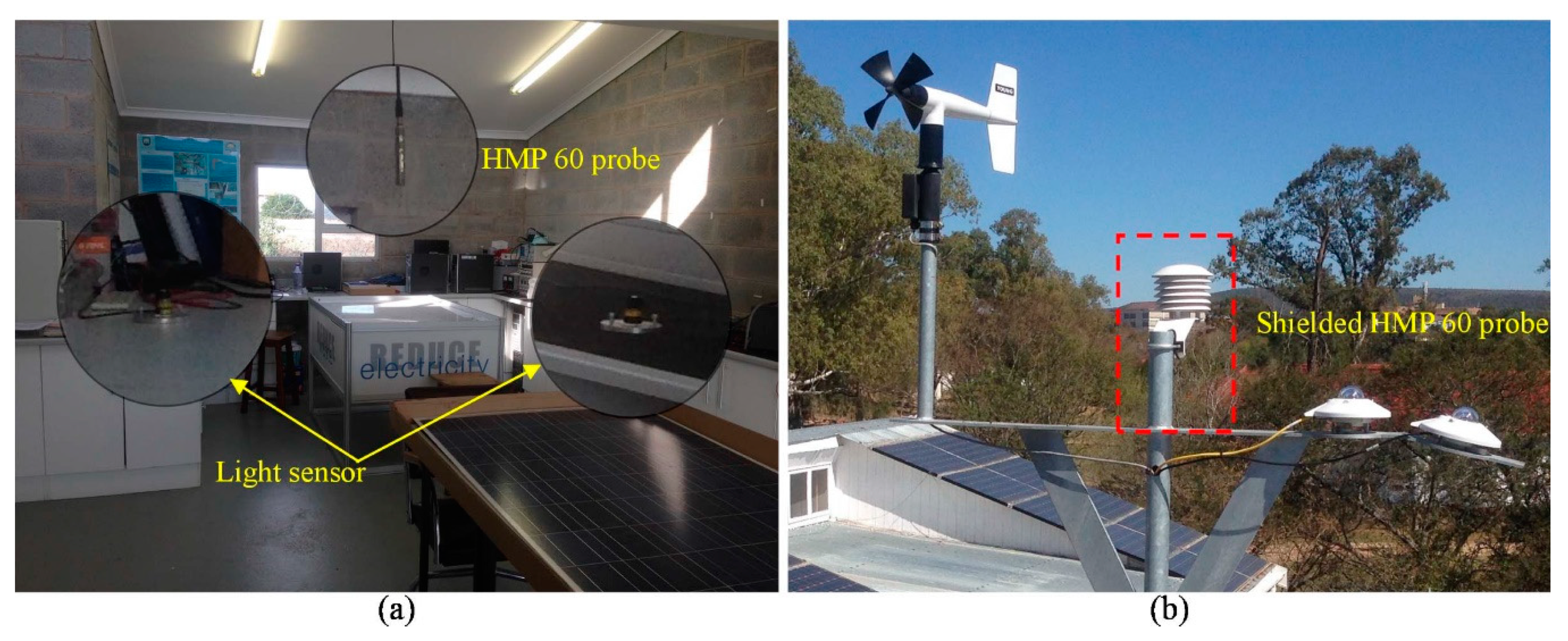

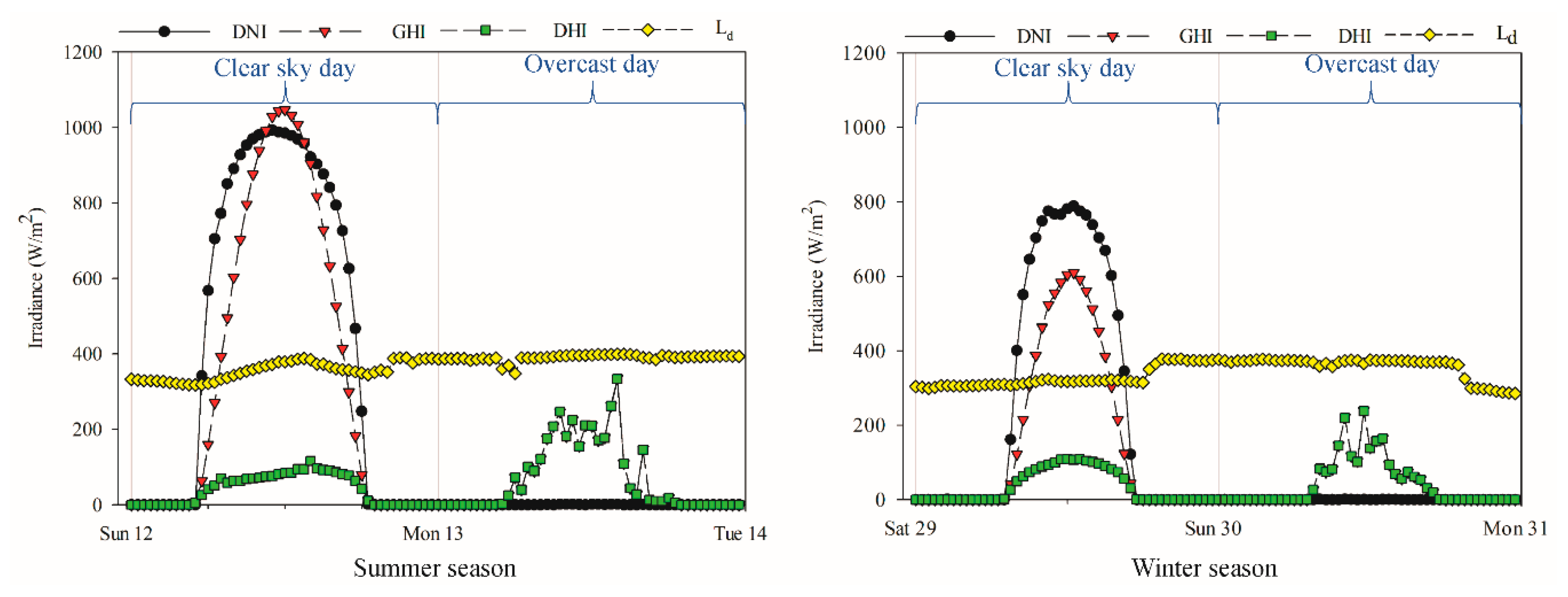
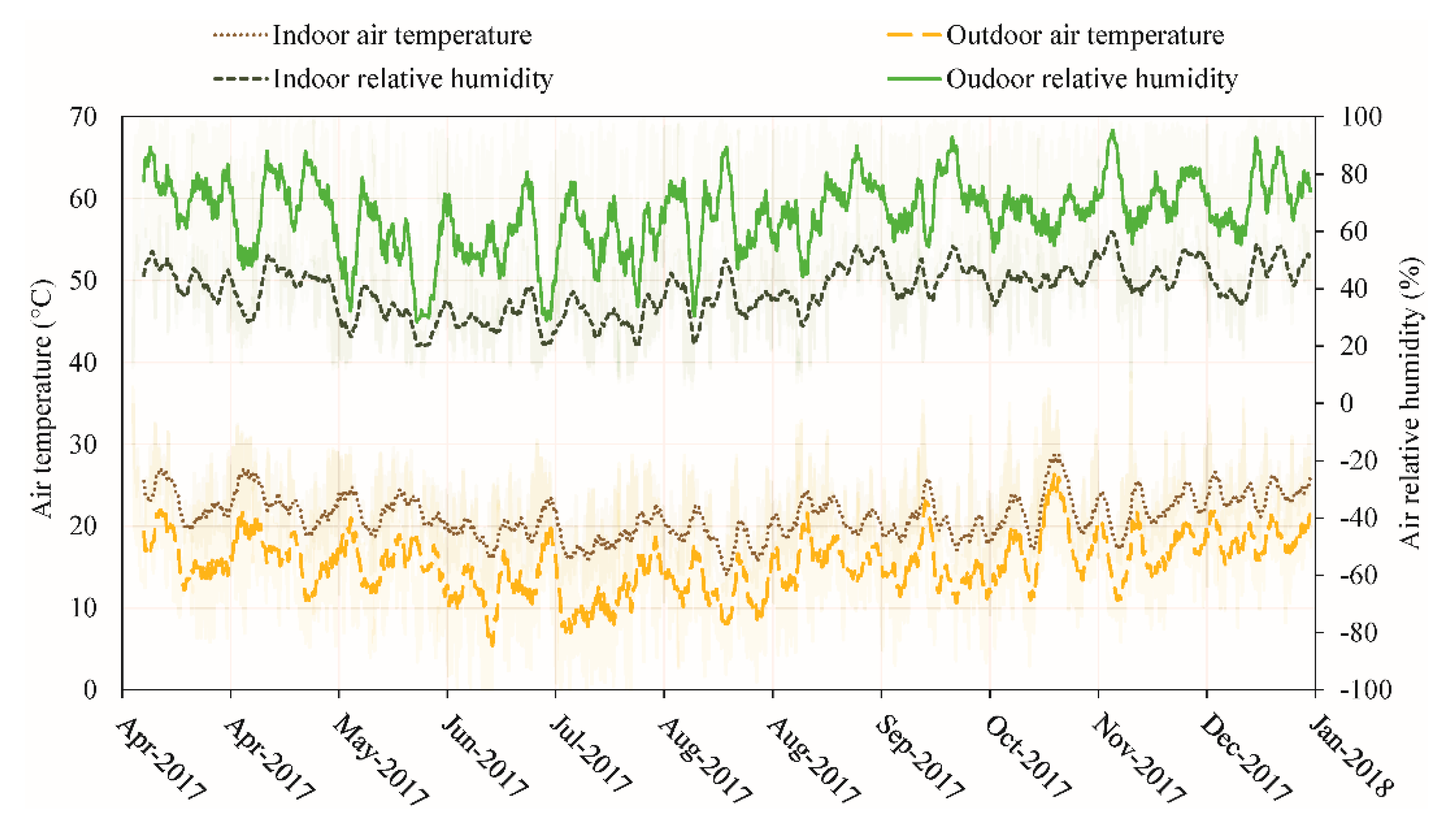

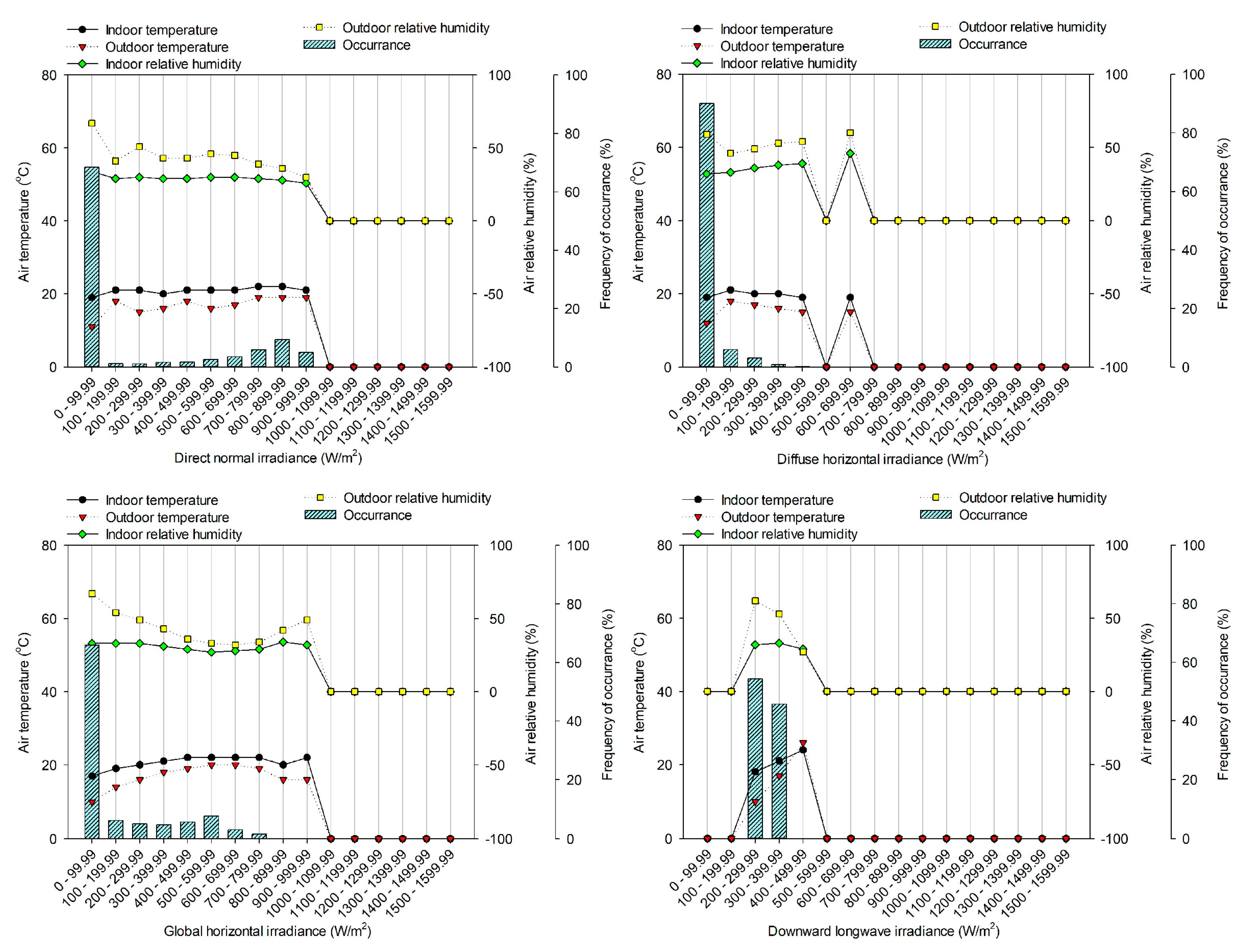
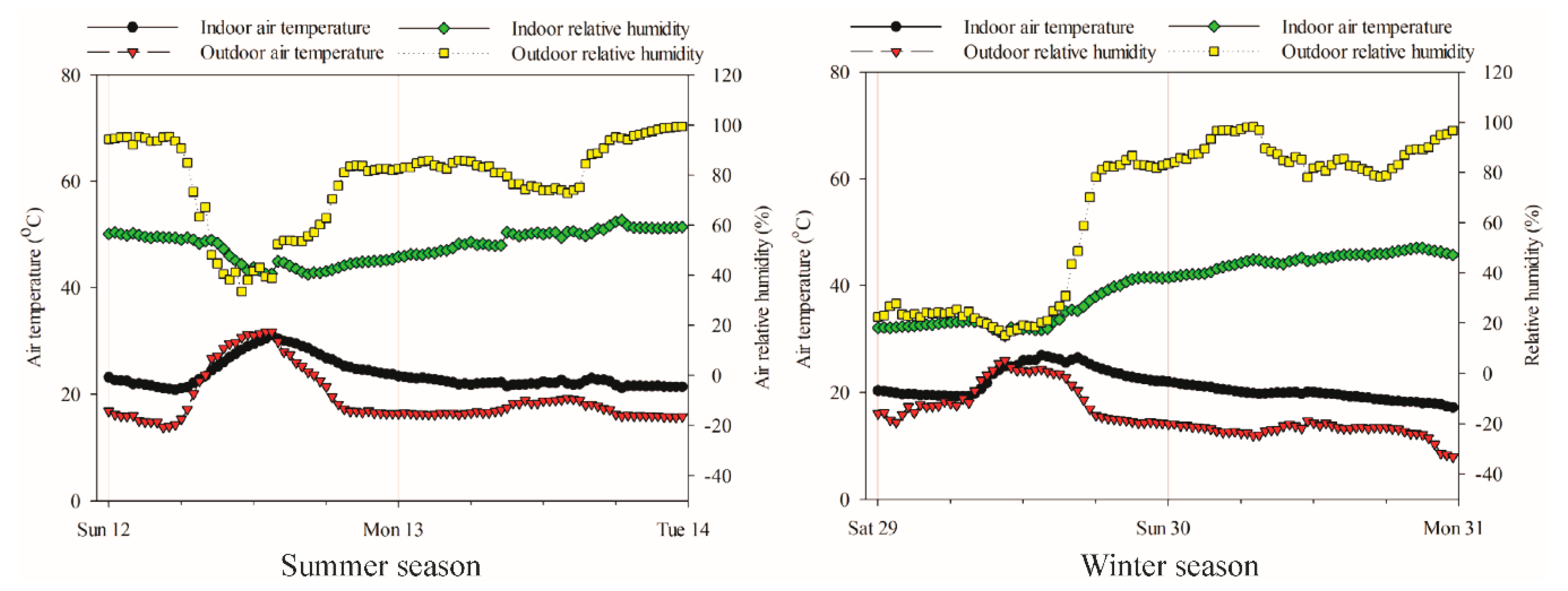

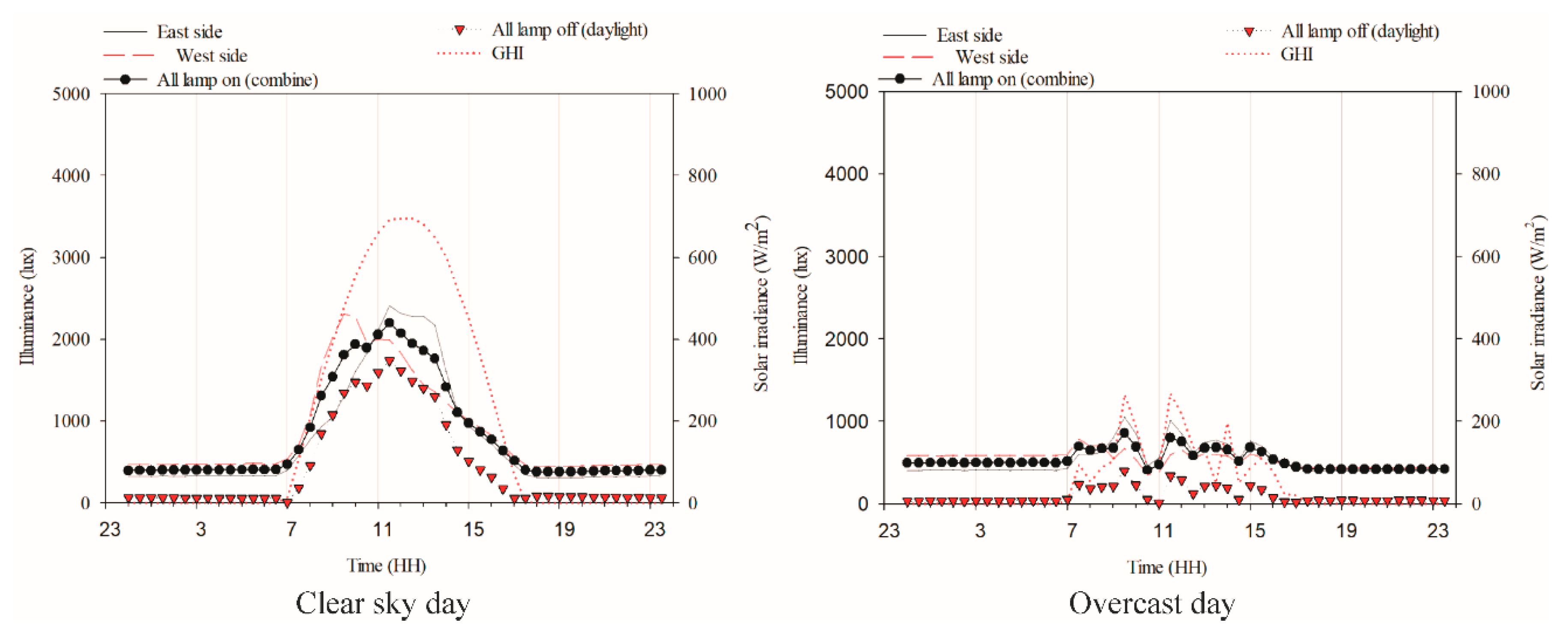
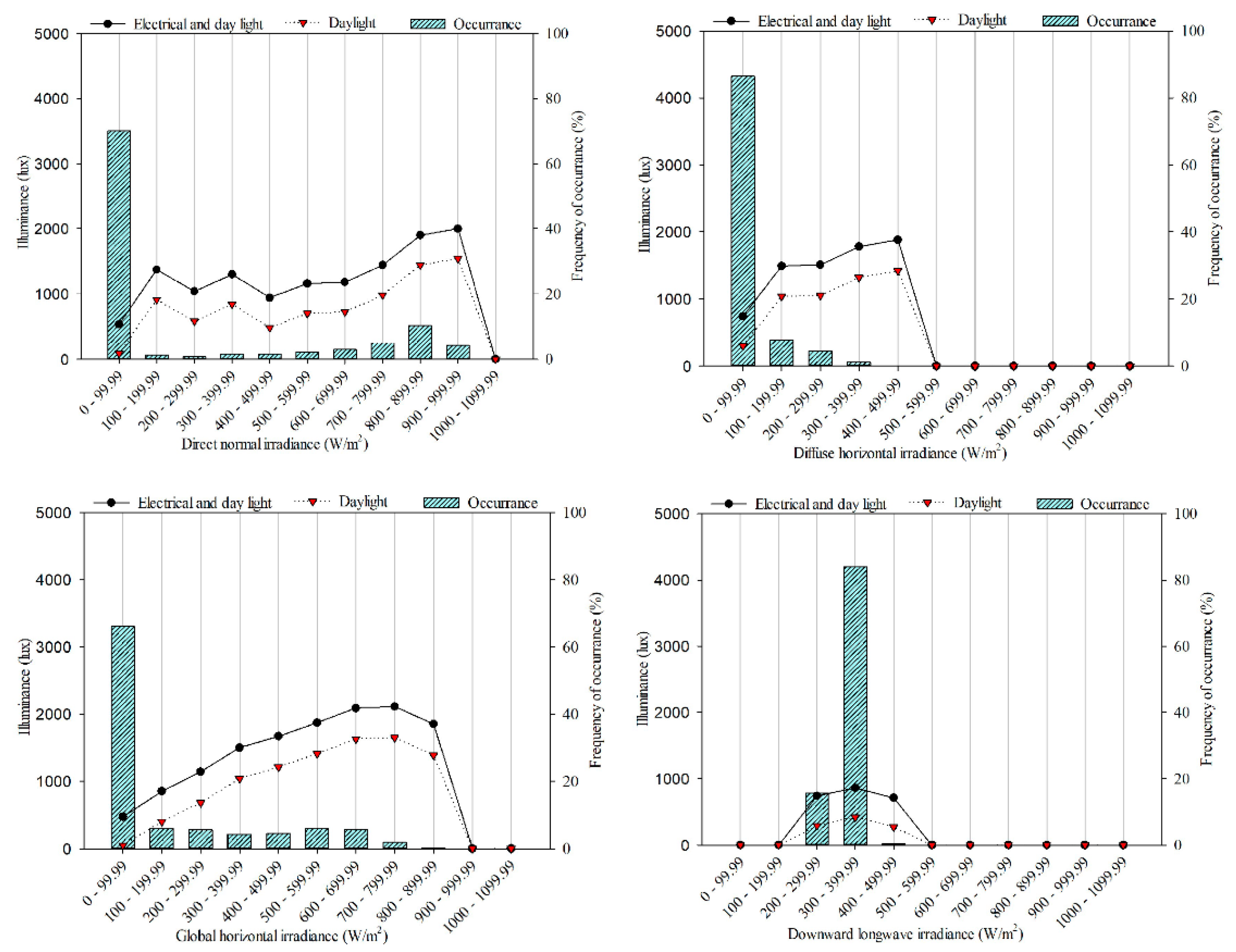
| Radiometer | Specification | ||
|---|---|---|---|
| Spectral Range (µm) | Sensitivity (µV/W/m2) | Response Time (s) | |
| Pyheliometer | 0.2 to 4 | 7 to 14 | <5 |
| Pyrgeometer | 4.5 to 42 | 5 to 10 | <18 |
| Pyranometer | 0.3 to 2.8 | 7 to 14 | <5 |
| Parameters | Measurement Range | Accuracy (±) | |
|---|---|---|---|
| Temperature (°C) | −40–60 | 0.6 | |
| Relative humidity (%) | at 0–40 °C | 0–90 | 3 |
| 90–100 | 5 | ||
| at 0–40 °C and +40–60 °C | 0–90 | 5 | |
| 90–100 | 7 | ||
| Season | Solar Radiation Component | Indoor Thermal Response | Outdoor Thermal Response | ||
|---|---|---|---|---|---|
| Temperature (°C/ħW/m2) | Relative Humidity (%/ħW/m2) | Temperature (°C/ħW/m2) | Relative Humidity (%/ħW/m2) | ||
| Summer | DNI | 0.5 | 1.0 | 1.0 | 3.9 |
| DHI | 0.7 | 1.6 | 1.3 | 4.5 | |
| GHI | 0.6 | 1.0 | 1.1 | 4.3 | |
| Ld | 0.6 | 0.3 | 0.9 | 1.1 | |
| Winter | DNI | 0.4 | 0.9 | 1.3 | 4.5 |
| DHI | 0.3 | 0.5 | 0.6 | 1.5 | |
| GHI | 0.6 | 1.1 | 1.0 | 3.7 | |
| Ld | 0.4 | 0.4 | 1.1 | 2.5 | |
| Solar Radiation Component | Illuminance Response (lux/ħW/m2) |
|---|---|
| DNI | 260 |
| DHI | 100 |
| GHI | 170 |
| Ld | 25 |
Publisher’s Note: MDPI stays neutral with regard to jurisdictional claims in published maps and institutional affiliations. |
© 2021 by the authors. Licensee MDPI, Basel, Switzerland. This article is an open access article distributed under the terms and conditions of the Creative Commons Attribution (CC BY) license (http://creativecommons.org/licenses/by/4.0/).
Share and Cite
Overen, O.K.; Meyer, E.L.; Makaka, G. Indoor Daylighting and Thermal Response of a Passive Solar Building to Selective Components of Solar Radiation. Buildings 2021, 11, 34. https://doi.org/10.3390/buildings11010034
Overen OK, Meyer EL, Makaka G. Indoor Daylighting and Thermal Response of a Passive Solar Building to Selective Components of Solar Radiation. Buildings. 2021; 11(1):34. https://doi.org/10.3390/buildings11010034
Chicago/Turabian StyleOveren, Ochuko Kelvin, Edson Leroy Meyer, and Golden Makaka. 2021. "Indoor Daylighting and Thermal Response of a Passive Solar Building to Selective Components of Solar Radiation" Buildings 11, no. 1: 34. https://doi.org/10.3390/buildings11010034
APA StyleOveren, O. K., Meyer, E. L., & Makaka, G. (2021). Indoor Daylighting and Thermal Response of a Passive Solar Building to Selective Components of Solar Radiation. Buildings, 11(1), 34. https://doi.org/10.3390/buildings11010034







